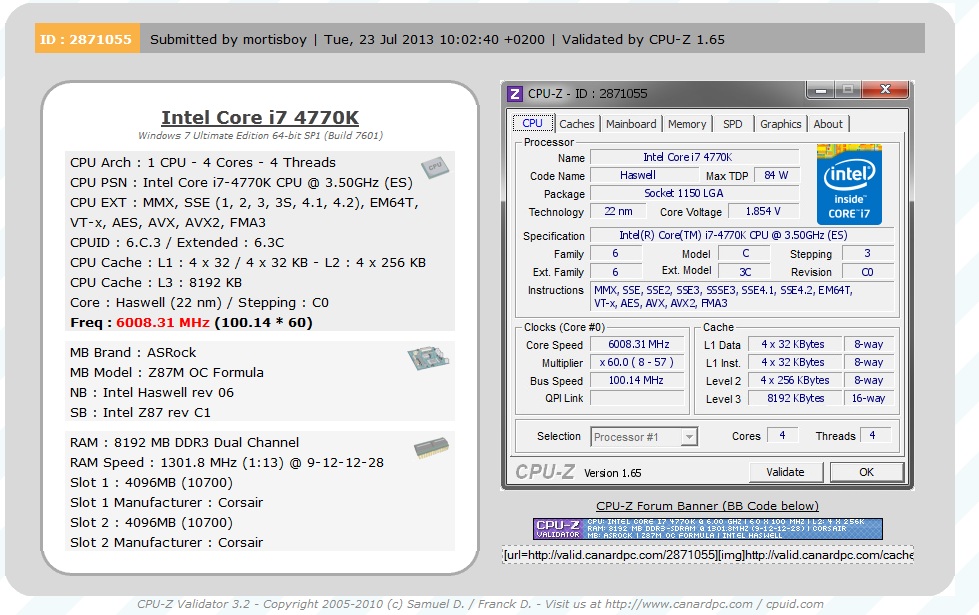 142
142
Intel Haswell i5-4670K vs. i7-4770K Comparison Review
Synthetic Benchmarks »System Setup
| Test System | |
|---|---|
| Processor: | Intel Core i5-4670K (Haswell, 6 MB Cache) Intel Core i7-4770K (Haswell, 8 MB Cache) |
| Motherboard: | Asrock Z87M OC Formula Intel Z87 |
| Graphics Processors: | Evga GTX 580 Classified |
| Memory: | 2x 4096 MB Corsair Platinum PC3-21300 DDR3 @ 2400 MHz 9-11-11-24 |
| Harddisk: | Corsair Neutron 64 GB |
| Cooling methods: | Prolimatech Megahalems EK WC Kit L360 with Supremacy CPU block |
| Power Supply: | Corsair AX 1200i |
| Software: | Windows 7 64-bit Service Pack 1 |
| Drivers: | NVIDIA: 320.18 WHQL |
| Display: | LG Flatron E2260" 1920x1080 |
Here is a photo of the system itself:
Overclocking
Maximizing clock frequency on the new Haswell series is exactly like overclocking an unlocked Ivy-Bridge CPU. However, this time, users have to deal with two additional voltages, vRing, also known as vCache, and vInput, also known as vRIN.vRing is responsible for cache voltage. It will help you overclock cache by changing its multiplier.
vInput sets the voltage the motherboard will supply to the integrated voltage regulator in the CPU. The iVR's purpose is to divide the voltage, supplying different components on the die itself. Some of these components are the cores, cache, and IMC.
For our tests, we overclocked by adjusting the multiplier on both processors. The maximum overlocks we achieved were 4.2 GHz at 1.26 V with the Core i5-4670K, 4.5 GHz at 1.29 V with the retail Core i7-4770K, and 4.7 GHz at 1.23 V with our Core i7-4770K ES.
The variance between overclocking potential from one chip to the next is quite large. I have tested more than four Core i7-4770Ks and only the good ES did 4.7 GHz on air with less than 1.3 V. It's also important to mention that the temperatures are different with the same ambient (room) temperatures and cooling methods. Some chips will produce higher temperatures because of the TIM (between CPU die and IHS) and the iVR.
Let us now take a look at the Core i7-4770K ES's overclocking results, since those are higher than with any other CPU I have tested on the Haswell platform.
Here is the maximum frequency we got on air.

Here is the maximum frequency we achieved with the Core i7-4770K on liquid nitrogen.

As you can see, we achieved a maximum frequency of 6 GHz, which is above average when it comes to Core i7-4770K overclocking. Unfortunately, the CPU cold bugged at -110°C, which means that it cannot operate at temperatures below -110°C.
Apr 25th, 2024 11:49 EDT
change timezone
Latest GPU Drivers
New Forum Posts
- WCG Daily Numbers (12496)
- TPU's Rosetta Milestones and Daily Pie Thread (1859)
- ThrottleStop 9.6 Voltage won't change (4)
- Folding Pie and Milestones!! (9008)
- Making Audio Enhancers Work on Windows (2649)
- Random blue screen from winload.efi error (0xc000000e) (1)
- which new soundcard or which 4.1 speakers kits ? (10)
- Alphacool CORE 1 CPU block - bulging with danger of splitting? (8)
- Free Games Thread (3767)
- Only EDP Other in Core? (0)
Popular Reviews
- Fractal Design Terra Review
- Thermalright Phantom Spirit 120 EVO Review
- Corsair 2000D Airflow Review
- Minisforum EliteMini UM780 XTX (AMD Ryzen 7 7840HS) Review
- ASUS GeForce RTX 4090 STRIX OC Review
- NVIDIA GeForce RTX 4090 Founders Edition Review - Impressive Performance
- ASUS GeForce RTX 4090 Matrix Platinum Review - The RTX 4090 Ti
- MSI GeForce RTX 4090 Suprim X Review
- MSI GeForce RTX 4090 Gaming X Trio Review
- Gigabyte GeForce RTX 4090 Gaming OC Review
Controversial News Posts
- Sony PlayStation 5 Pro Specifications Confirmed, Console Arrives Before Holidays (116)
- NVIDIA Points Intel Raptor Lake CPU Users to Get Help from Intel Amid System Instability Issues (106)
- AMD "Strix Halo" Zen 5 Mobile Processor Pictured: Chiplet-based, Uses 256-bit LPDDR5X (101)
- US Government Wants Nuclear Plants to Offload AI Data Center Expansion (98)
- Windows 11 Now Officially Adware as Microsoft Embeds Ads in the Start Menu (92)
- Developers of Outpost Infinity Siege Recommend Underclocking i9-13900K and i9-14900K for Stability on Machines with RTX 4090 (85)
- AMD's RDNA 4 GPUs Could Stick with 18 Gbps GDDR6 Memory (84)
- Windows 10 Security Updates to Cost $61 After 2025, $427 by 2028 (84)

